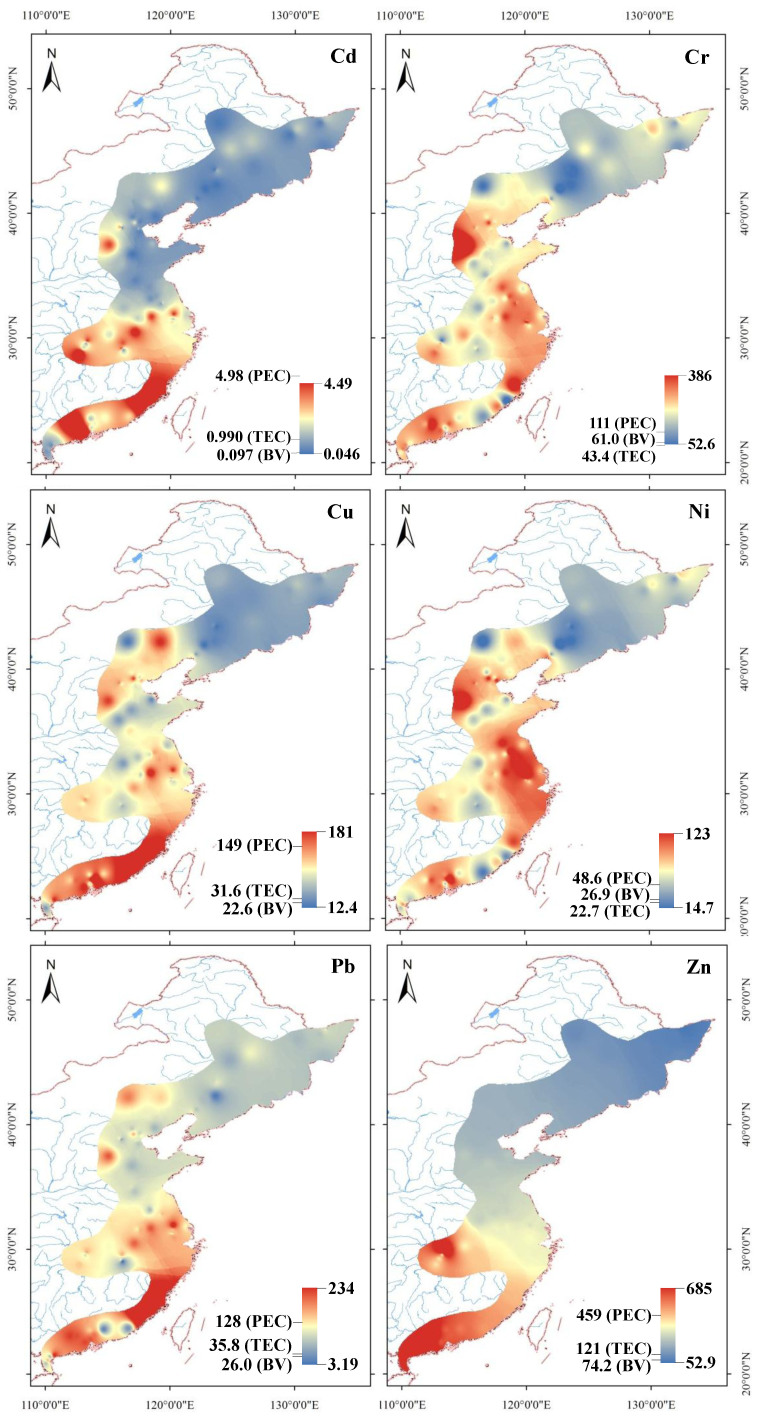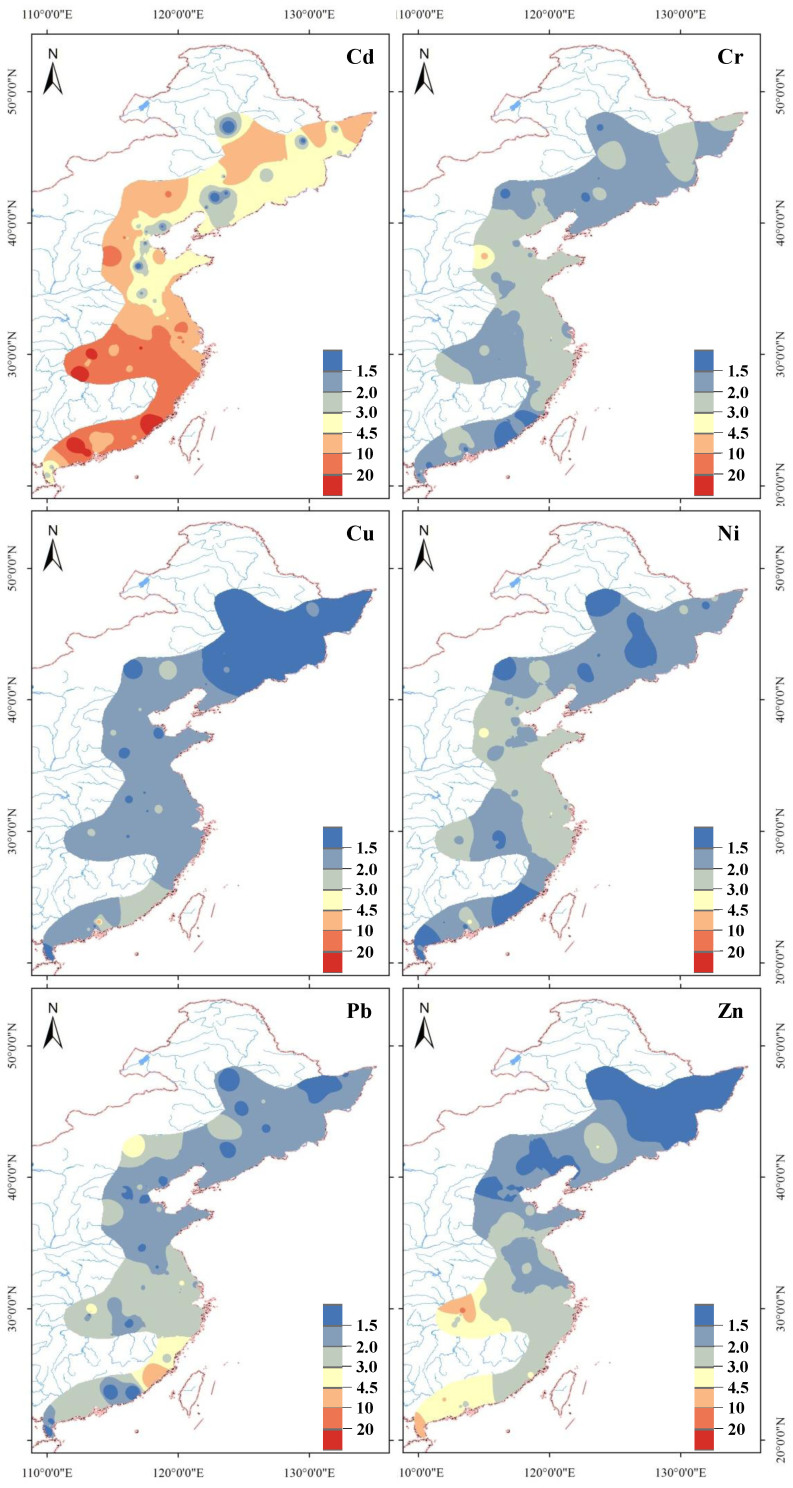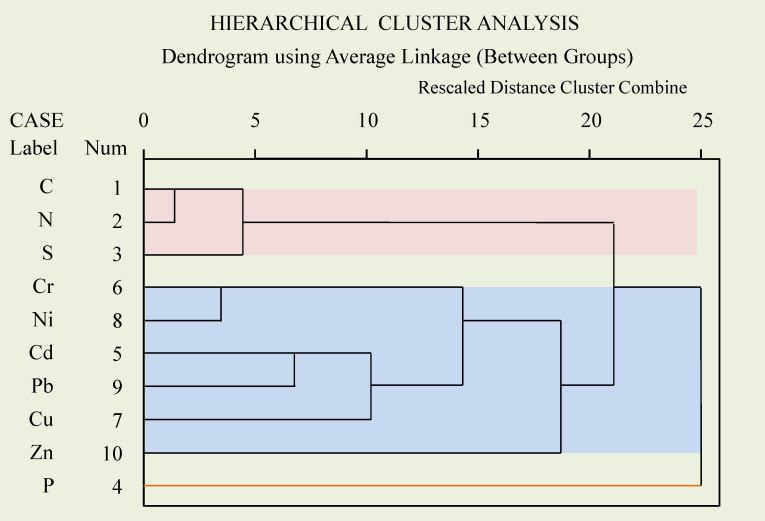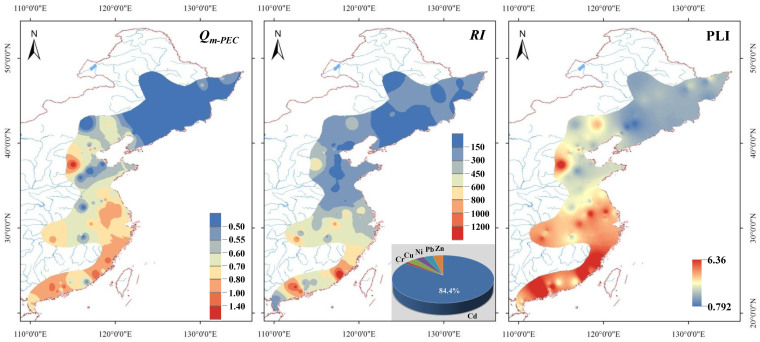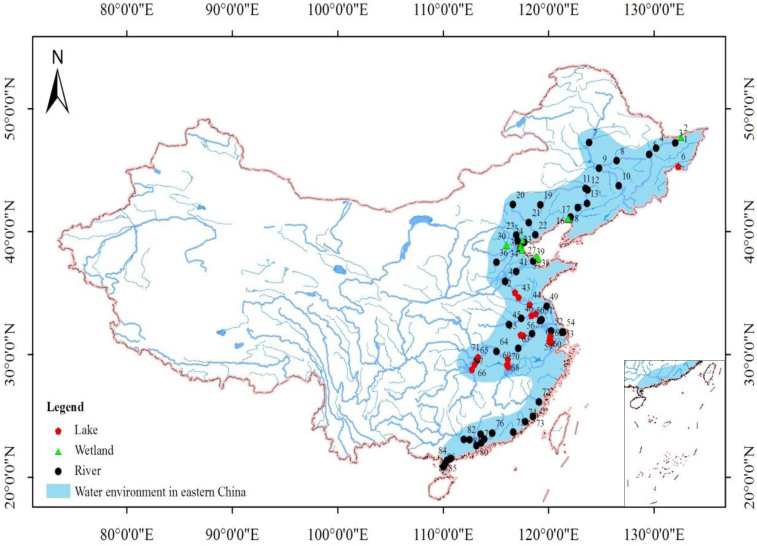Abstract
A comprehensive analysis of heavy metal pollution was conducted in the representative limnetic ecosystems of eastern China, which are subject to rapid economic development and population growth. The results demonstrated that the average contents with standard deviations of Cd, Cr, Cu, Ni, Pb and Zn in the surface sediments were 0.925 ± 0.936, 142 ± 46.8, 54.7 ± 29.1, 60.5 ± 21.6, 61.9 ± 36.0 and 192 ± 120 mg/kg dry wt., respectively, and that higher values were mainly observed in the southern portion of the study area, especially in the basins of Southeast Coastal Rivers (SCRB) and the Zhu River (ZRB). The six heavy metals in the surface sediments all had anthropogenic origins. In addition, the limnetic ecosystems, especially in the southern portion of the study area were found to be polluted by heavy metals, especially Cd. Overall, two hotspots of heavy metal pollution in the limnetic ecosystems of eastern China were found, one that consisted of the heavy pollution regions, SCRB and ZRB, and another composed of Cd pollution. These results indicate that heavy metal contamination, especially Cd, should be taken into account during development of management strategies to protect the aquatic environment in the limnetic ecosystems of eastern China, especially in the two aforementioned basins.
Heavy metal pollution in aquatic ecosystems is a worldwide environmental problem that has received increasing attention over the last few decades because of its adverse effects1,2,3,4,5. The contamination of aquatic systems by heavy metals, especially in sediments, has become one of the most challenging pollution issues owing to the toxicity, abundance, persistence, and subsequent bio-accumulation of these materials6,7. When discharged into aquatic ecosystems, heavy metals can be absorbed by suspended solids, then strongly accumulated in sediments and biomagnified along aquatic food chains8,9. Moreover, these sediments act as sinks, and may in turn act as sources of heavy metals10,11. Thus, heavy metal pollution in the sediments of aquatic ecosystems has recently been extensively investigated to effectively manage these ecosystems6,12,13,14.
In China, environmental problems owing to heavy metal pollution of sediments received little attention from researchers and governments prior to 20004,15. Recently, anthropogenic activities for economic development, especially by industry have intensified continuously and rapidly, particularly in eastern China. Consequently, one-sixth of all arable lands in China have been contaminated by heavy metals16, and heavy metal pollution is becoming increasingly serious and has been extensively investigated in the sediments of limnetic ecosystems (river, lake, wetland, etc.) in eastern China4,6,8,17. Although extensive investigations of heavy metals in sediments have been carried out in the study area, these studies have mainly focused on individual ecosystems, and there have been few investigations of whole limnetic ecosystems in this area.
Therefore, this study was conducted to evaluate heavy metal pollution status in the sediments of limnetic ecosystems located in eastern China, including rivers, lakes and wetlands. The specific goals of this study were: 1) to investigate heavy metal contents (Cd, Cr, Cu, Ni, Pb and Zn) in the surface sediments; 2) to determine if they were of natural or anthropogenic origin based on enrichment factor (EF), Pearson correlation analysis (CA), hierarchical cluster analysis (HACA), and principal components analysis (PCA); and 3) to assess the risk associated with the six heavy metals by consensus-based sediment quality guidelines (SQGs), potential ecological risk (PER) index, geo-accumulation index (Igeo), and pollution load index (PLI).
Results and Discussion
Properties and nutrient contents of surface sediments
As shown in Figure S1, the pH of surface sediments in the studied ecosystems ranged from 5.23 to 8.94 with an average of 7.73, higher than the soil background value (pH = 6.70)18. Additionally, the OM ranged from 0.551% to 16.6% with an average of 5.33, while the TC, TN, TS and TP contents varied from 0.124%, 0.009%, 0.010% and 0.018% to 13.5%, 0.967%, 0.994% and 0.293%, respectively, with an average of 1.87%, 0.143%, 0.123% and 0.057%. The TC and TN contents had basically the same spatial distribution patterns, with the highest values being observed in the surface sediments from HaRB, HuRB and YaRB (TC: 2.85%, 2.44% and 1.84%; TN: 0.230%, 0.162% and 0.140%, respectively). The TS and TP contents were highest in HaRB (0.196% and 0.084%, respectively).
Heavy metal contents of surface sediments
The heavy metal contents of surface sediments are shown in Figure 1, and comparative analyses of the threshold effect concentration (TEC), probable effect concentration (PEC), and background value (BV) are presented in Table S1. The average contents with standard deviations of Cd, Cr, Cu, Ni, Pb and Zn across the basins were 0.925 ± 0.936, 142 ± 46.8, 54.7 ± 29.1, 60.5 ± 21.6, 61.9 ± 36.0 and 192 ± 120 mg/kg dry wt., respectively. In general, the contents of these metals in the sediments of the study area were at the medium level compared with those reported from other areas12,19,20. Spatially, heavy metal contents were higher in the southern portion of the study area than in the north. The average Cd contents were highest in the surface sediments of SCRB (2.57 mg/kg dry wt.), ZRB (1.48 mg/kg dry wt.) and YaRB (1.38 mg/kg dry wt.), while the average Cr and Zn contents were highest in ZRB (161 and 417 mg/kg dry wt., respectively), the Cu and Pb contents were highest in SCRB (113 and 147 mg/kg dry wt., respectively) and the average Ni contents were highest HuRB (70.7 mg/kg dry wt.).
Figure 1. Heavy metal contents (mg/kg) of surface sediments (ArcGIS 10.0).
PEC, probable effect concentration; TEC, threshold effect concentration; BV, background value.
Upon analysis of all sediment samples, the percentages of Cd, Cr, Cu, Ni, Pb and Zn contents exceeding the PEC values were 0.0%, 79.1%, 1.1%, 68.6%, 3.5% and 7.0%, respectively, indicating that adverse effects caused by Cr and Ni are expected. When compared with the BV, the percentages exceeding the values were all over 90.0% (Table S1), indicating that the heavy metals all had different degrees of accumulation in the sediments of the study area.
Heavy metal sources of surface sediments
The EF values of all analyzed metals were calculated to evaluate anthropogenic influences on heavy metals in the surface sediments of the study area. The spatial distribution and basic statistics for the EF values are shown in Figure 2 and Figure S2. An EF value between 0.5 and 1.5 suggests that the metal may be entirely from crustal materials or natural weathering processes. However, an EF greater than 1.5 suggests that a significant portion of the metal originated from anthropogenic processes6,21,22,23. The EF values of Cd were highest in this study, reaching 7.92 on average, indicating a high degree of anthropogenic contamination by this metal, mainly from industrial activities. The mean values of Zn, Pb, Cu, Cr and Ni were 2.25, 2.06, 2.04, 2.02 and 1.95, respectively, indicating that they also originated from anthropogenic sources in most samples.
Figure 2. Heavy metal enrichment factor distribution of surface sediments (ArcGIS 10.0).
Various multivariate techniques such as CA, HACA and PCA have been shown to be useful for identification of sources of heavy metals6. In the present study, a high positive correlation (p ≤ 0.01) was observed among heavy metals (except Ni and Zn, p ≤ 0.05) (Table S2), as well as among C, N and S. However, no significant correlation was observed between P and other elements. Similar to the results of CA, the studied elements could be roughly clustered into three primary groups obtained by HACA (Figure 3). The first cluster consisted of C, N and S, the second included the six heavy metals and the third contained only P. In addition, three major components representing different levels of anthropogenic input were extracted from the six heavy metals. The first component included Cr and Ni, the second Cd, Pb and Cu, and the last one Zn. PCA was also applied to identify sources of these anthropogenic components. The relationships among the studied elements based on the three principal components were illustrated in three-dimensional (3D) space (Figure S3), and the results agreed with those of CA and HACA. Overall, these findings indicate that the six heavy metals in the surface sediments of the study area all had anthropogenic origins. Moreover, the degrees of enrichment of the heavy metals were as follows: Cd > Zn > Pb > Cu > Cr > Ni, and these metals could be divided into three sources.
Figure 3. Hierarchical dendrogram of metal elements of surface sediments (SPSS Statistics 17.0).
Risk associated with heavy metals
The risks associated with the studied metals in the surface sediments of the study area were assessed by consensus-based SQGs, PER index, Igeo and PLI. With the exception of the HeRB and LRB, the mean PEC quotient (Qm-PEC) of the surface sediments from HaRB, YeRB, HuRB, YaRB, SCRB and ZRB were larger than 0.5 (0.662, 0.528, 0.666, 0.741, 0.879 and 0.846, respectively), indicating that these sediments were toxic and highly contaminated by heavy metals (Figure 4).
Figure 4. Risk assessments of heavy metals in the surface sediments (ArcGIS 10.0).
Qm-PEC, mean probable effect concentration quotient; RI, comprehensive potential ecological risk index; PLI, pollution load index.
PER represents the sensitivity of the biological community to a given substance and illustrates the risk posed by contamination4,6. In the surface sediments of the studied limnetic ecosystems, the sequence of Eir was Cd > Zn > Cu > Pb > Ni > Cr, and the studied metals all showed low PER with the exception of Cd, Cu, Pb and Zn, which were present in 87.2%, 1.2%, 2.3% and 2.3% of the sediment samples, respectively (Table S3). The Eir values of Cd ranged from 13.9 to 1389 with an average of 286, indicating high Cd contamination of the sediments in the study area. These findings were consistent with the results obtained from EF, as well as those of different aquatic ecosystems in this area24. The mean RI values of the surface sediments were 175, 122, 244, 168, 205, 487, 879 and 534 in HeRB, LRB, HaRB, YeRB, HuRB, YaRB, SCRB and ZRB, respectively, with an overall average of 339 (Figure 4). According to the PER index (Table S4), many stations in the SCRB and ZRB had high and serious contamination, primarily as a result of Cd pollution (Figure 4). This may have been owing to mining and metallurgical industry development in these basins. The distribution plots of RI developed in the present study could be useful in identifying stations that need the most attention in the study area.
To further examine the heavy metal pollution in the surface sediments, the Igeo of each heavy metal was determined (Figure S4 and Figure S5). The mean Igeo values of Cd, Cr, Cu, Ni, Pb and Zn were 1.97, 0.559, 0.497, 0.483, 0.482 and 0.578, respectively. These findings indicate that the sediments were moderately polluted with Cd, while they were unpolluted to moderately polluted with the other heavy metals (Table S4). Spatially, the degree of Cd pollution in the surface sediments of the SCRB and ZRB were all strongly polluted (Igeo = 4.00 and 2.78, respectively), which is in accordance with the Qm-PEC and RI values. In addition, the results were further confirmed by the PLI, and the values exceeded one at over 95.0% of the stations indicating that heavy metal pollution existed in the study area, especially in the SCRB and ZRB (Figure 4 and Table S4).
Heavy metals are widespread and persistent in aquatic ecosystems, potentially toxic, and can become incorporated into food webs11,25. Sediments contaminated with heavy metals have been found to be via several pathways, including atmospheric deposition, industrial activities and agricultural activities26,27. In the current study, heavy metals, especially Cd, all showed different degrees of enrichment in the surface sediments (Figure 2), which has resulted in toxicity, PER, and pollution (Figure 4 and Figure S4). Moreover, economic development and population growth in the study area have influenced the distribution of heavy metals in the sediments, especially in the HaRB, which is the most developed region and has the highest population density in eastern China (Figure 1 and Figure S6)16. However, mining and metallurgical industries were found to be the dominant factors responsible for heavy metal enrichment, especially in the SCRB and ZRB. Taken together, these results indicate that heavy metal pollution of sediments, particularly Cd, has become a major environmental problem in the limnetic ecosystems of eastern China, which is consistent with the results of other studies4,14,16,21. Moreover, sediment contaminants may move into the food chain, and heavy metals in the sediments can accumulate in relatively large amounts in aquatic organisms without any apparent effects, resulting in a threat to human health28,29,30. Accordingly, it is important that heavy metal contaminants, especially Cd, be carefully monitored in the study area. The information obtained in this study could be useful in the development of effective management strategies for control of heavy metal pollution in the limnetic ecosystems of eastern China.
Methods
Study area
Eastern China is the most developed region of China and has the highest population density. Rapid economic development and population growth have caused significant pollution of aquatic ecosystems in this area. The representative limnetic ecosystems investigated in this study include lakes, wetlands and rivers located in the basins of the Heilong River (HeRB), Liao River (LRB), Hai River (HaRB), Yellow River (YeRB), Huai River (HuRB), Yangtze River (YaRB), Southeast Coastal Rivers (SCRB) and Zhu River (ZRB), within the provinces of Heilongjiang, Liaoning, Hebei, Province, Jiangsu, Anhui, Hubei and Guangdong, and the municipalities of Beijing, Tianjin and Shanghai (Figure 5). In addition, point (mainly due to industrial development) and non-point (mainly agricultural development and urbanization) sources have caused severe heavy metal pollution in the aquatic ecosystems of eastern China (mainly plains)14,24.
Figure 5. Map showing the sampling stations (ArcGIS 10.0).
Sample collection and analysis
Surface sediments (0–10 cm) were collected from August to October 2013 at eighty-six sampling stations (Figure 5 and Table S5) using a Peterson grab sampler. Five parallel samples were collected from each station (Figure S7). Samples (n = 430) were air-dried, then dried in an oven at 40°C, after which they were ground and passed through a 100-mesh sieve prior to analysis.
Sediment pH was determined after mixing samples with water at a sediment: water ratio of 1:2.531. The organic matter (OM) content was determined by residual titration of K2Cr2O732, The total carbon (TC), nitrogen (TN) and sulfur (TS) were measured using an element analyzer (Vario EL III, Elementar, Germany), while the total phosphorus (TP) of the sediment samples was analyzed by the HClO4-H2SO4 digestion method32. For total heavy metal analysis, sediment samples (0.100 g) were digested with a 5:l mixture of hydrofluoric: perchloric acid33 in a microwave digestion system (MARS Xpress; CEM, Matthews, NC, USA) under the conditions presented in Table S6. All of the above solutions were stored at 4°C prior to analysis. The concentrations of P, Cd, Cr, Cu, Ni, Pb, Zn and Fe were measured by inductively coupled plasma optical emission spectrometry (ICP-OES) (Optima 2000DV; Perkin Elmer, Waltham, MA, USA) (detection limit 0.001–0.030 mg/L) and inductively coupled plasma-mass spectrometry (ICP-MS) (7500a; Agilent Technologies, Santa Clara, CA, USA) (detection limit 0.015–0.120 μg/L). Laboratory quality control consisted of analysis of sediment reference material (GBW07302a; National Institute of Metrology, Beijing, China) and triplicate samples. The recoveries all fell within the range of 90%–110%, and the relative standard deviation was less than 5%.
Enrichment factor and risk assessment
To obtain information regarding the sources and factors influencing metals in the studied sediments, EF values of metals were calculated according to the following equation34,35.
 |
where Cn is the metal content in the sediments, Bn is the background content of the metal, CFe is the Fe content in the sediments, and BFe is the background content of Fe. In this study, the soil background values of the studied regions were adopted as the baseline values18. In addition, the risk associated with heavy metals in the surface sediments were assessed using consensus-based SQGs36, the PER index10,37, Igeo38 and PLI39 as described in (Table S4).
Statistical analysis
The experimental data were analyzed by SPSS Statistics 17.0 for Windows. CA was used to assess the relationship of heavy metal contents and sediment properties, while HACA and PCA were carried out to identify potential sources of the metals40. In addition, ArcGIS 10.0 and Origin Pro 8.0 were used to plot the experimental data.
Author Contributions
W.T. and B.S. designed and coordinated the study. W.T., W.Z., Y.D., N.R. and X.Z. performed the experiments. W.T., B.S. and H.Z. were involved in analyzing the data. W.T. and Y.Z. contributed analysis tools. W.T. and B.S. wrote the paper and all the authors participated in revising. All authors have read and approved the final manuscript.
Supplementary Material
Supporting Information
Acknowledgments
This work was supported by the National Natural Science Foundation of China (No. 21107126), the National Water Pollution Control Program of China (No. 2012ZX07203-006), and the One-Three-Fiver Program of Research Center for Eco-Environmental Sciences (No. YSW2013B02).
References
- Iksandar I. K. & Keeney D. R. Concentration of heavy metals in sediment cores from selected Wisconsin lakes. Environ. Sci. Technol. 8, 165–170 (1974). [Google Scholar]
- Allengil S. M. et al. Heavy metal accumulation in sediment and freshwater fish in US Arctic lakes. Environ. Toxicol. Chem. 16, 733–741 (1997). [Google Scholar]
- Kim I. S., Kang K. H., Johnson-Green P. & Lee E. J. Investigation of heavy metal accumulation in Polygonum thunbergii for phytoextraction. Environ. Pollut. 126, 235–243 (2003). [DOI] [PubMed] [Google Scholar]
- Ma Z., Chen K., Yuan Z., Bi J. & Huang L. Ecological risk assessment of heavy metals in surface sediments of six major Chinese freshwater lakes. J. Environ. Qual. 42, 341–350 (2013). [DOI] [PubMed] [Google Scholar]
- Wang Y. M., Kinraide T. B., Wang P., Zhou D. M. & Hao X. Z. Modeling rhizotoxicity and uptake of Zn and Co singly and in binary mixture in wheat in terms of the cell membrane surface electrical potential. Environ. Sci. Technol. 47, 2831–2838 (2013). [DOI] [PubMed] [Google Scholar]
- Fu J. et al. Heavy metals in surface sediments of the Jialu River, China: Their relations to environmental factors. J. Hazard. Mater. 270, 102–109 (2014). [DOI] [PubMed] [Google Scholar]
- Barlas N., Akbulut N. & Aydogan M. Assessment of heavy metal residues in the sediment and water samples of Uluabat Lake, Turkey. B. Environ. Contam. Tox. 74, 286–293 (2005). [DOI] [PubMed] [Google Scholar]
- Yi Y., Yang Z. & Zhang S. Ecological risk assessment of heavy metals in sediment and human health risk assessment of heavy metals in fishes in the middle and lower reaches of the Yangtze River basin. Environ. Pollut. 159, 2575–2585 (2011). [DOI] [PubMed] [Google Scholar]
- Gumgum B., Unlu E., Tez Z. & Gulsun Z. Heavy-metal pollution in water, sediment and fish from the Tigris River in Turkey. Chemosphere 29, 111–116 (1994). [DOI] [PubMed] [Google Scholar]
- Håkanson L. An ecological risk index for aquatic pollution control: A sedimentological approach. Water Res. 14, 975–1001 (1980). [Google Scholar]
- Suresh G., Sutharsan P., Ramasamy V. & Venkatachalapathy R. Assessment of spatial distribution and potential ecological risk of the heavy metals in relation to granulometric contents of Veeranam lake sediments, India. Ecotox. Environ. Safe. 84, 117–124 (2012). [DOI] [PubMed] [Google Scholar]
- Vukosav P. et al. Heavy metal contents in water, sediment and fish in a karst aquatic ecosystem of the Plitvice Lakes National Park (Croatia). Environ. Sci. Pollut. R. 21, 3826–3839 (2014). [DOI] [PubMed] [Google Scholar]
- Xiao H. F. et al. Assessment of potential risks associated with heavy metal contamination in sediment in Aobaopao Lake, China, determined from sediment cores. Ecotoxicology 23, 527–537 (2014). [DOI] [PubMed] [Google Scholar]
- Zhang L. W. & Shao H. B. Heavy metal pollution in sediments from aquatic ecosystems in China. Clean–Soil, Air, Water 41, 878–882 (2013). [Google Scholar]
- He M. C., Wang Z. J. & Tang H. X. The chemical, toxicological and ecological studies in assessing the heavy metal pollution in Le An River, China. Water Res. 32, 510–518 (1998). [Google Scholar]
- Tang W. Z., Zhao Y., Wang C., Shan B. Q. & Cui J. G. Heavy metal contamination of overlying waters and bed sediments of Haihe Basin in China. Ecotox.Environ. Safe. 98, 317–323 (2013). [DOI] [PubMed] [Google Scholar]
- Xin K. et al. Land use change impacts on heavy metal sedimentation in Mangrove Wetlands - A case study in Dongzhai Harbor of Hainan, China. Wetlands 34, 1–8 (2014). [Google Scholar]
- China National Environmental Monitoring Center. The Background Concentrations of Soil Elements in China. (China Environmental Science Press, Beijing, 1990). [Google Scholar]
- Singh K. P., Mohan D., Singh V. K. & Malik A. Studies on distribution and fractionation of heavy metals in Gomti river sediments - a tributary of the Ganges, India. J. Hydrol. 312, 14–27 (2005). [Google Scholar]
- Woitke P. et al. Analysis and assessment of heavy metal pollution in suspended solids and sediments of the river Danube. Chemosphere 51, 633–642 (2003). [DOI] [PubMed] [Google Scholar]
- Tang W. Z., Shan B. Q., Zhang H. & Mao Z. P. Heavy metal sources and associated risk in response to agricultural intensification in the estuarine sediments of Chaohu Lake Valley, East China. J. Hazard. Mater. 176, 945–951 (2010). [DOI] [PubMed] [Google Scholar]
- Zhang J. & Liu C. L. Riverine composition and estuarine geochemistry of particulate metals in China - weathering features, anthropogenic impact and chemical fluxes. Estuar. Coast. Shelf S. 54, 1051–1070 (2002). [Google Scholar]
- Menge D. N. L., Hedin L. O. & Pacala S. W. Nitrogen and phosphorus limitation over long-term ecosystem development in terrestrial ecosystems. PLoS ONE 7, e42045 (2012). [DOI] [PMC free article] [PubMed] [Google Scholar]
- Tang W. et al. Heavy metal pollution characteristics of surface sediments in different aquatic ecosystems in eastern china: A comprehensive understanding. PLoS ONE 9, e108996 (2014). [DOI] [PMC free article] [PubMed] [Google Scholar]
- Taweel A., Shuhaimi-Othman M. & Ahmad A. K. Assessment of heavy metals in tilapia fish (Oreochromis niloticus) from the Langat River and Engineering Lake in Bangi, Malaysia, and evaluation of the health risk from tilapia consumption. Ecotox. Environ. Safe. 93, 45–51 (2013). [DOI] [PubMed] [Google Scholar]
- Li H. & Davis A. P. Heavy metal capture and accumulation in bioretention media. Environ. Sci. Technol. 42, 5247–5253 (2008). [DOI] [PubMed] [Google Scholar]
- Tang W. Z., Ao L., Zhang H. & Shan B. Q. Accumulation and risk of heavy metals in relation to agricultural intensification in the river sediments of agricultural regions. Environ. Earth Sci. 71, 3945–3951 (2014). [Google Scholar]
- Lambert R., Grant C. & Sauve S. Cadmium and zinc in soil solution extracts following the application of phosphate fertilizers. Sci. Total Environ. 378, 293–305 (2007). [DOI] [PubMed] [Google Scholar]
- Satarug S., Garrett S. H., Sens M. A. & Sens D. A. Cadmium, environmental exposure, and health outcomes. Environ. Health Persp. 118, 182–190 (2010). [DOI] [PMC free article] [PubMed] [Google Scholar]
- Tang W., Cui J., Shan B., Wang C. & Zhang W. Heavy Metal Accumulation by Periphyton Is Related to Eutrophication in the Hai River Basin, Northern China. PLoS ONE 9, e86458 (2014). [DOI] [PMC free article] [PubMed] [Google Scholar]
- Empresa Brasileira de Pesquisa Agropecuária. Centro Nacional de Pesquisa de Solos. (Embrapa CNPS, Rio de Janeiro, 1997). [Google Scholar]
- Bao S. D. Soil and Agricultural Chemical Analysis. (Chinese Agricultural Publisher, Beijing, 2000). [Google Scholar]
- Tessier A., Campbell P. G. C. & Bisson M. Sequential extraction procedure for the speciation of particulate trace metals. Anal. Chem. 51, 844–851 (1979). [Google Scholar]
- Zhang H. & Shan B. Q. Historical records of heavy metal accumulation in sediments and the relationship with agricultural intensification in the Yangtze-Huaihe region, China. Sci. Total Environ. 399, 113–120 (2008). [DOI] [PubMed] [Google Scholar]
- Guo W. H., Liu X. B., Liu Z. G. & Li G. F. Pollution and potential ecological risk evaluation of heavy metals in the sediments around Dongjiang Harbor, Tianjin. Procedia Environ. Sci. 2, 729–736 (2010). [Google Scholar]
- MacDonald D. D., Ingersoll C. G. & Berger T. Development and evaluation of consensus-based sediment quality guidelines for freshwater ecosystems. Arch. Environ. Con. Tox. 39, 20–31 (2000). [DOI] [PubMed] [Google Scholar]
- Liu Y. J. et al. Direct and indirect influences of 8 yr of nitrogen and phosphorus fertilization on Glomeromycota in an alpine meadow ecosystem. New Phytol. 194, 523–535 (2012). [DOI] [PubMed] [Google Scholar]
- Müller G. Index of geoaccumulation in sediments of the Rhine River. Geojournal 2, 108–118 (1969). [Google Scholar]
- Tomlinson D. L., Wilson J. G., Harris C. R. & Jeffrey D. W. Problems in the assessment of heavy-metal levels in estuaries and the formation of a pollution index. Helgol. Meeresunters. 33, 566–575 (1980). [Google Scholar]
- Brereton R. G. Chemometrics: Data Analysis for the Laboratory and Chemical Plant. (Wiley, 2003). [Google Scholar]
Associated Data
This section collects any data citations, data availability statements, or supplementary materials included in this article.
Supplementary Materials
Supporting Information



